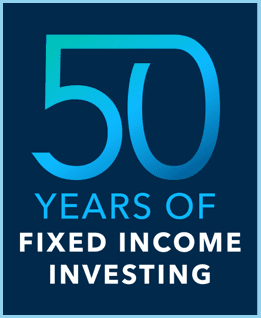Coupon rate is the rate of interest paid by bond issuers on the bond's face value. It is the periodic rate of interest paid by bond issuers to its purchasers. The coupon rate is calculated on the bond’s face value (or par value), not on the issue price or market value.
Duration is a measure of the sensitivity of the price of a fixed income investment to a change in interest rates.
The return of principal for bond funds and for funds with significant underlying bond holdings is not guaranteed. Fund shares are subject to the same interest rate, inflation and credit risks associated with the underlying bond holdings. The use of derivatives involves a variety of risks, which may be different from, or greater than, the risks associated with investing in traditional cash securities, such as stocks and bonds. Lower rated bonds are subject to greater fluctuations in value and risk of loss of income and principal than higher rated bonds.
Investing outside the United States involves risks, such as currency fluctuations, periods of illiquidity and price volatility, as more fully described in the prospectus. These risks may be heightened in connection with investments in developing countries.
As a nondiversified fund, American Funds Emerging Markets Bond Fund has the ability to invest a larger percentage of assets in securities of individual issuers than a diversified fund. As a result, a single issuer could adversely affect a fund’s results more than if the fund invested a smaller percentage of assets in securities of that issuer. See the applicable prospectus for details.
The indexes are unmanaged and, therefore, have no expenses. Investors cannot invest directly in an index.
The Bangkok SET Index is a capitalization-weighted index of stocks traded on the Stock Exchange of Thailand.
Bloomberg U.S. Aggregate Index represents the U.S. investment-grade fixed-rate bond market.
The London Bullion Market Association (LBMA) Gold Price benchmarks are the global benchmark prices for unallocated gold delivered in London, stated as the price per troy ounce in U.S. dollars and administered by ICE Benchmark Administration Limited.
The NASDAQ Composite Index tracks the performance of more than 3,000 stocks listed on the NASDAQ and is often viewed as an indicator for the technology-related sectors of the economy.
The Nikkei 225 Index, also referred to as the Nikkei Stock Average, is a price-weighted equity index, which consists of 225 stocks in the Prime Market of the Tokyo Stock Exchange.
The NYSE Arca Biotech Index is a capitalization-weighted index consisting of roughly 30 companies that are primarily involved in the biotechnology industry and the use of biological processes to develop products or provide services.
The NYSE FANG+ Index is an equal-weighted equity benchmark designed to track the performance of 10 highly traded growth stocks of technology and tech-enabled companies in the technology, media & communications and consumer discretionary sectors.
S&P 500 Index is a market capitalization-weighted index based on the results of approximately 500 widely held common stocks.
The S&P Homebuilders Select Industry Index is an equal-weighted index that comprises stocks from the S&P Total Market Index that are classified in the GICS Homebuilding sub-industry.
BLOOMBERG® is a trademark and service mark of Bloomberg Finance L.P. and its affiliates (collectively “Bloomberg”). Bloomberg or Bloomberg’s licensors own all proprietary rights in the Bloomberg Indices. Neither Bloomberg nor Bloomberg’s licensors approves or endorses this material, or guarantees the accuracy or completeness of any information herein, or makes any warranty, express or implied, as to the results to be obtained therefrom and, to the maximum extent allowed by law, neither shall have any liability or responsibility for injury or damages arising in connection therewith.
© 2023 NYSE Euronext. All Rights Reserved.
The S&P 500 Index (“Index”) is a product of S&P Dow Jones Indices LLC and/or its affiliates and has been licensed for use by Capital Group. © 2023 S&P Dow Jones Indices LLC, a division of S&P Global, and/or its affiliates. All rights reserved. Redistribution or reproduction in whole or in part is prohibited without written permission of S&P Dow Jones Indices LLC.







